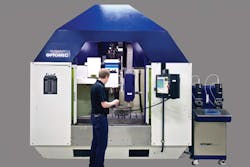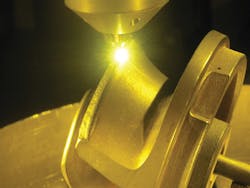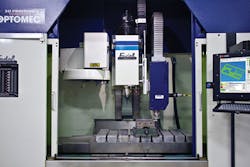Hybrids accelerate adoption of laser additive manufacturing
Just as hybrids are ushering in a smooth and steady transition to a more efficient and ecological driving experience, the same approach is bringing big changes to industrial manufacturing—especially in the use of lasers. While laser metal additive manufacturing has clear benefits, there are still a number of factors preventing its full adoption for industrial use. This article will discuss some of those barriers and the technological advances being made to break them down to accelerate the adoption of laser metal additive manufacturing.
Gaining steam in the industry is a hybrid approach that combines the advantages of traditional CNC subtractive machine tools with laser metal additive manufacturing. Integrating these two technologies by upgrading an existing machine tool has many promising benefits. The machinist gains access to laser metal additive technology without disrupting subtractive machining or changing the size of the footprint required on the production floor. This approach significantly lowers the adoption cost of laser metal additive technology by retrofitting an existing machine, as well as in training time by using a human machine interface (HMI) familiar to the machinist. Cost can be further minimized by using a laser additive manufacturing approach that uses off the shelf materials available from commercial suppliers. Indeed, users of a hybrid system can have the best of both worlds—the familiarity of a conventional subtractive machine tool plus the benefits of new additive manufacturing capabilities, including building complete metal components or adding 3D structures onto conventionally manufactured components or even restoring worn or damaged parts all on the same machine tool (FIGURE 1).
Adoption barriers
Laser metal additive manufacturing technology has been available for more than 20 years, yet less than 2000 commercial systems have been sold worldwide. Some of the barriers preventing widespread adoption include:
High equipment cost. Production-grade laser metal additive manufacturing systems are expensive, with system acquisition costs ranging from $750,000 to well over $1 million.
Limited-size work envelope. The average size work envelope for a production-grade laser metal additive manufacturing system is about one cubic foot. If processing a larger part size is required, custom engineering will be required to build a special platform to process the component, which adds to the overall cost.
Difficult to use. Laser metal additive manufacturing systems have a unique HMI, making it difficult for a user to learn and operate. Therefore, special training is required, increasing operating cost.
Material cost. Most laser additive manufacturing system suppliers require customers to use metal powder feedstock, which can only be purchased directly from the equipment supplier. This increases material cost and supplier risk factors.
Of course, there are other important issues preventing this technology from being fully adopted, such as the need for laser metal additive manufacturing industry standards, part qualification and certification approvals, and process controls for part-to-part consistency. However, the cost barrier is the biggest obstacle.
Hybrid additive/subtractive machine tools
CNC subtractive machine tools are the workhorse of the metal working industry. Over 100,000 new CNC machines are sold annually to the aerospace, automotive, and other industries producing durable goods, and there are millions of these tools installed cutting metal throughout the manufacturing industry. The platform for subtractive metal cutting machine tools—stages, servo motors and drives, and multi-axis motion controllers—is basically the same as what is used on laser additive manufacturing machine tools. What if it were possible to upgrade an existing metal cutting CNC machine tool with laser additive manufacturing capabilities? What if this upgrade could be accomplished without compromising the machine tool's subtractive machining capabilities? What if the laser additive manufacturing process could utilize the machine tool's motion control system to build metal parts? What if the upgraded machine could switch back and forth between laser additive and subtractive operations in a hybrid manner on the same part? And how would these capabilities affect the adoption cost of laser additive manufacturing technology? These questions were recently asked in a project challenge issued by America Makes, the National Additive Manufacturing Innovation Institute (Youngstown, OH). But before we answer these questions, it's necessary to first take a step back to better understand the laser metal additive manufacturing process.
Laser metal additive manufacturing basics
Additive manufacturing is an industrial production technique in which digital design data, either from a CAD model or scanner, is used to deposit material, layer by layer, to form a complete component. This technique is widely known as 3D printing. The additive manufacturing process has been used by industrial companies worldwide for more than 30 years to build plastic parts for prototyping purposes. Laser metal additive manufacturing technology has been available for over 20 years and has recently come to the forefront because of successful use at companies such as General Electric on projects such as the LEAP engine . Cost savings can be realized with the laser additive manufacturing approach through a reduction of material waste and time required for fabrication of hard tooling. The additive manufacturing process also enables unique product design capabilities such as internal cavities that can reduce part weight or the use of multiple materials for graded metal structures. Applications for laser metal additive manufacturing technology span the entire product lifecycle, from the rapid development of new alloys, to rapid prototyping of functional parts, to low-volume manufacturing, and to component repair and rework.
The two most common laser metal additive manufacturing technologies are "powder bed" and "powder fed." In powder-bed systems, a laser is used to selectively melt a bed of metallic powder in a layer-by-layer process to build up the physical part. In powder-fed systems, the process continuously blows powder through nozzles at the focal point of a high-powered laser forming a melt pool, which is then moved through a motion control system to build up the part layer by layer. Powder-bed machines are better at building smaller, more complex shapes with good surface finish. Powder-fed machines, such as the Optomec LENS system (FIGURE 2), are better at adding material to existing parts, or building larger parts with higher-performance mechanical properties. In addition to building larger parts, the unique ability of the LENS metal process to add materials to existing components enables additional applications such as part repair, wear coatings, and hybrid manufacturing.The powder-fed process mainly uses common engineering materials, such as stainless steels, tool steels, titanium alloys, and cobalt alloys. It can also process a wide variety of more exotic materials, such as some ceramics, refractory metals, and others. These materials are available in powder form from a variety of commercial suppliers. Prices vary based on material type. For example, the cost of stainless steel powder is about $10 per pound.
The powder-fed process makes a layered finish on the sides of the part (typically 12–25μm Ra) and a smoother finish on top. Practically, this means that metal laser-manufactured parts may need a moderate amount of finish machining in the same way that a weldment or casting requires finish machining. Many studies have been performed comparing laser metal-deposited material properties to conventional cast or forged material. In general, laser additive manufacturing technology produces fully dense material that has mechanical properties at least equal to or better than cast material, and in many cases very similar to forged or wrought material.
The LENS Print Engine
Now, let's go back to the America Makes project challenge to lower adoption barriers, especially those that are cost-related, for laser metal additive manufacturing technology. Optomec responded with a proposal to package its LENS technology into a modular print engine that could be integrated with other metal working platforms such as CNC mills, lathes, robots, custom gantries, or even laser cutting and welding systems. The concept was validated by upgrading a legacy CNC vertical mill with the LENS Print Engine.
Basic LENS Print Engine components include a deposition head with optics, a laser, and a powder feeder (FIGURE 3). Optional components include a motion controller, safety upgrades for machine tool enclosure, and process controls. Various print heads for bulk cladding, precision 3D printing, and non-line-of-sight deposition can be utilized based on application requirements.In May 2015, a 1990s Fadal Vertical Mill upgraded with a LENS Print Engine was unveiled at TechSolve (Cincinnati, OH), a company with expertise in evaluating and testing metal working machine tools. Using stainless steel powder, the hybrid system added a keyway onto a shaft and then finish-machined the surface with one setup and toolpath. Laser safety upgrades and motion controls for the system were provided by MachMotion (Newburgh, MO), a company experienced in retrofitting legacy CNC machine tools. A TechSolve machinist programmed the Fadal hybrid system for both additive and subtractive operations using standard G codes. Operator training time was one day. TechSolve will continue evaluating the hybrid system, examining the effect of cutting fluid coolants on the laser additive manufacturing process and the effect of powder on the machine tool stages. A second system was delivered to the Golisano Institute for Sustainability at the Rochester Institute of Technology, where it will be evaluated for remanufacturing and repair applications.
The promise of the future
Retrofitting an existing CNC machine to include laser metal additive manufacturing is a cost-effective way to put an exciting technology into a production setting. Hybrid systems open up the potential to bring laser metal additive capabilities, still an evolving and elite technology on its own, to mainstream manufacturing. The ability to switch between subtractive and additive techniques on a single machine and on the same part enables conventional and additive manufacturing methods to be utilized together for optimum cost and time efficiencies. Laser metal additive manufacturing presents the opportunity to create intricate features and to design products with closed geometries. Additive capabilities also equip a CNC machine tool to perform precision repair applications or to add wear surfaces to components to extend useful life.
The upgrade cost to retrofit an existing subtractive machine tool with laser metal additive manufacturing technology ranges from $200,000 to $500,000, depending upon what components are needed. This is significantly less than the high equipment cost of a standalone laser metal additive system. Creating a hybrid by retrofitting an existing machine tool used in production also means that its work envelope will match the customer's part size requirements and that no additional floor space will be required. It means, too, that operators will be able to use a familiar HMI. It's still early days for hybrid laser metal additive/subtractive machines, but the outlook is promising. Adopting the use of hybrid additive/subtractive machines may well be one of the most important steps toward the future of industrial manufacturing.
ACKNOWLEDGEMENT
LENS is a registered trademark of Optomec.
REFERENCES
1. See http://bit.ly/1Idxoaf.
2. See http://bit.ly/1OTprLN.
3. See http://bit.ly/1fQ3Tn5.
4. T. Rockstroh, D. Abbott, K. Hix, and J. Mook, "Additive manufacturing at GE Aviation," Industrial Laser Solutions, 28, 11, 4–6 (Nov. 2013).
5. See http://bit.ly/1IP9MhE.


